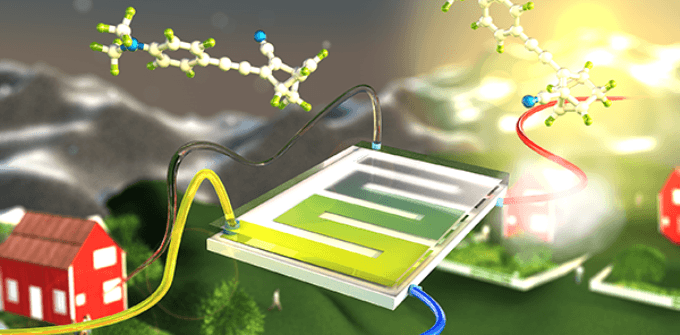Mar 21 2017
 (Credit: Chalmers University of Technology)
(Credit: Chalmers University of Technology)
Efficient solar energy storage in a chemical liquid has been demonstrated by a team of scientists at Chalmers University of Technology in Sweden. The stored energy can be transported and then discharged as heat whenever required. The research has been displayed on the cover of the scientific journal Energy & Environmental Science.
Many consider the sun as the energy source of the future. However there is one challenge - storing solar energy and delivering the energy ‘on demand’ is difficult.
The scientists from Chalmers University of Technology have demonstrated that solar energy can be converted directly into energy stored in the bonds of a chemical fluid – a type of molecular solar thermal system.
The liquid chemical makes it viable to store and transport the stored solar energy and discharge whenever required, with complete recovery of the storage medium. The whole process relies on the organic compound norbornadiene. Upon exposure to light, norbornadiene converts into quadricyclane.
The technique means that that we can store the solar energy in chemical bonds and release the energy as heat whenever we need it. Combining the chemical energy storage with water heating solar panels enables a conversion of more than 80 percent of the incoming sunlight.
Professor Kasper Moth-Poulsen, Chalmers University of Technology
More than six years ago this research project was started at Chalmers, and the research team had contributed to a primary conceptual demonstration in 2013. At the time, they achieved a solar energy conversion efficiency of 0.01 % and the expensive element ruthenium was the major player in the compound.
Now, four years later, the system is able to store 1.1 % of the incoming sunlight as latent chemical energy – an improvement of a factor of 100. Also, ruthenium was replaced by cheaper carbon-based elements.
We saw an opportunity to develop molecules that make the process much more efficient. At the same time, we are demonstrating a robust system that can sustain more than 140 energy storage and release cycles with negligible degradation.
Professor Kasper Moth-Poulsen, Chalmers University of Technology
The Swedish Foundation for Strategic Research and the Knut and Alice Wallenberg Foundation funded the research.
Videos about the research:
Can molecules solve the problem with storing solar energy?
Den perfekta molekylen för lagring av solenergi, Kasper Moth-Poulsen, Chalmers